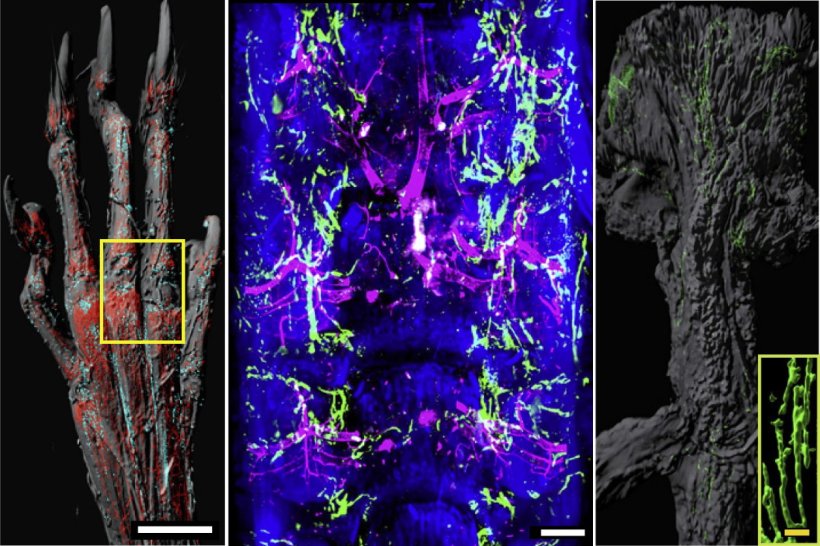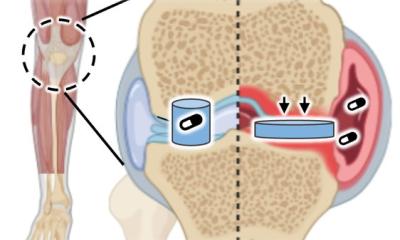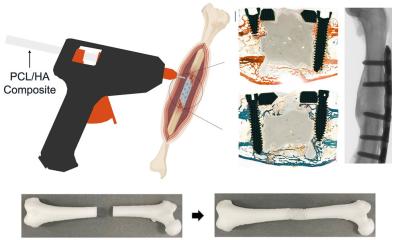
Image source: Biswas et al., Cell 2023 (CC BY 4.0)
News • Regeneration support
Role of lymphatic system in bone healing revealed
It was previously assumed that bones lacked lymphatic vessels, but new research from the MRC Human Immunology Unit at Oxford's MRC Weatherall Institute for Molecular Medicine not only locates them within bone tissue, but demonstrates their role in bone and blood cell regeneration and reveals changes associated with aging.
It was previously assumed that bones lacked lymphatic vessels, but new research from the MRC Human Immunology Unit at Oxford's MRC Weatherall Institute for Molecular Medicine not only locates them within bone tissue, but demonstrates their role in bone and blood cell regeneration and reveals changes associated with aging.
The lymphatic system is a network of vessels that branch out throughout the body, and play an important role in draining excess fluid from tissues, clearing waste products and supporting immune responses. The fine network of lymph vessels extends throughout the body, but a small number of sites such as the brain, eye and bone were previously assumed to lack lymph tissue. The hard tissue of bone in particular has traditionally made studying the distribution and role of blood and lymph more difficult.
New research published in Cell uses light-sheet imaging to overcome these barriers, identifying and visualising the lymphatic vessels of bone in high-resolution 3D. Researchers discovered an active network of lymph vessels within bone and further identified some of the key signals happening between lymph vessels, blood stem cells and bone stem cells.
Interestingly after injury, lymphatic vessels in bone show dynamic crosstalk with blood stem cells and with specialized perivascular cells in order to accelerate bone healing
Lincoln Biswas
Dr Lincoln Biswas, a Post-Doctoral Research Associate in the MRC Human Immunology Unit and co-first author of this study, said: 'Interestingly after injury, lymphatic vessels in bone show dynamic crosstalk with blood stem cells and with specialized perivascular cells in order to accelerate bone healing. Such interactions between lymphatics and bone stem cells can harnessed to promote bone healing such as in fracture repair.'
The researchers found that lymphatic vessels in bone increase during injury via a signalling molecule called IL6, and trigger expansion of bone progenitor cells by secreting a different signal, called CXCL12. Dr Junyu Chen, a co-first author of the study now based at Sichuan University said: 'Aging is associated with diminished capacity for bone repair, and our findings show that lymphatic signalling is impaired in aged bones. Remarkably, the administration of young lymphatic endothelial cells restores healing of aged bones, thus providing a future direction to promote bone healing in elderly.'

Image credit: Dr Anjali Kusumbe
Dr Anjali Kusumbe, Group Leader of the Tissue and Tumor Microenvironments Group at the MRC Human Immunology Unit, who led the research said: 'I am very excited as these findings not only demonstrate that lymphatic vessels do exist in bone but also reveal their critical interactions with blood stem cells and perivascular bone stem cells after injury to promote healing, thereby presenting lymphatics as a therapeutic avenue to stimulate bone and blood regeneration. Further, these findings are very fundamental, opening doors for understanding the impact of bone lymphatics on the immune system and their role in bone and blood diseases.'
Lymph vessels were shown not only to be present in bone, but to play a role in bone and blood cell regeneration. Exploring the role of aging on bone lymphatic vessels, they found that aging bones showed reduced expansion of lymphatic vessels in response to injury. The researchers aim to expand on this research to explore the role of lymphatic vessels in bone-based diseases such as rheumatoid arthritis, and to explore the potential for new therapeutic approaches to treat bone and blood diseases.
'The lab used innovative imaging techniques to identify the presence of lymphatics within bones for the first time. Kusumbe then defined roles for these bone lymphatics in blood and immune cell production and bone regeneration which were impaired during aging. These disruptive findings have important ramifications for age related disorders of the bone and immune system,' says Professor Alison Simmons, Director of the MRC Human Immunology Unit at the University of Oxford. 'As such the work will act as a foundation for a variety of future endeavours focused on this new anatomy, from discovery to translation.'
Source: University of Oxford
24.01.2023










